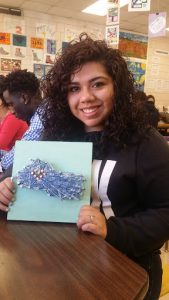Claudia was a student in my period 4 foundations class. She is Puerto Rican and El Salvadorian, and has lived in Worcester her entire life. She was an 11th grade student, placed in a mixed class of freshmen, mostly sophomores, and juniors. Claudia did not join the class until the third week of school, but she did not hesitate to jump right into the work. She was reasonably quiet during class unless she was asking me for help or clarification, but occasionally still laughed at her friend’s jokes. She put tremendous effort into all her work and had a strong will to do well.

Claudia holds up her finished project on positive and negative space: a string art map of El Salvador.
While many of the other students came to class late, Claudia was frequently among the first to arrive. She promptly got her art notebook to answer the bell ringer or found her project to continue working on it. If the class was in the middle of a project, she always knew what to do when she entered the classroom and did not hesitate to start on her work. If the class was starting a new project, she was eager to learn. She would be focused on her work throughout every class period, and rarely left her seat to even use the restroom.
Earlier in the year, she would be unsure of her answer to the bell ringers or how to explain herself but ultimately was able to put something down in her notebook. For example, the bell ringer on September 14th was “what is a gesture drawing?” Claudia wrote that “a gesture drawing is a laying of the action form or pose.” Her answer may not make the most grammatical sense, but I could tell that she understood the concept of a gesture drawing. She was able to show me that she knew a gesture drawing to be a snapshot of a movement, a series of quick lines that give the impression of an action or pose. That is what I looked for in the bell ringers, that students were able to show they understood the concept and not that they were able to regurgitate the dictionary definition verbatim. Claudia was also one of very few students who had done the small homework assignments that were assigned. I remember one day she brought a homework assignment in the next day and presented it to me without even needing to be asked for it. Most of the other students did not even know homework had been assigned.
Claudia, who had not taken an art class since 6th grade and who told me that she learns best when the teacher shows steps slowly and explains mistakes to her personally, was able to successfully demonstrate that she understood the concepts I taught because I took the time to break down each project into manageable steps and modeled each step for the students. She gained the confidence to practice skills on her own and apply those skills to various projects. Claudia was also able to help other students work on their projects because she had become more knowledgeable and could act as a mentor.
When I look back at Claudia’s classwork, I can see that she was putting in a lot of effort. She took her time to hone the skills I taught, and tried really hard to make even her practice exercises look good. She was constantly calling me over to help make her work better or ask what she could do next. She looked for validation in her work and I could see that she appreciated when I gave her positive feedback. She also appreciated when I gave constructive criticism and worked to rectify her mistakes instead of becoming upset or angry at me. Over time, Claudia produced higher quality work that exhibited a stronger understanding of the concepts and application of techniques. Several times I chose her work to be displayed on the classroom walls as an example of meeting my high expectations.
